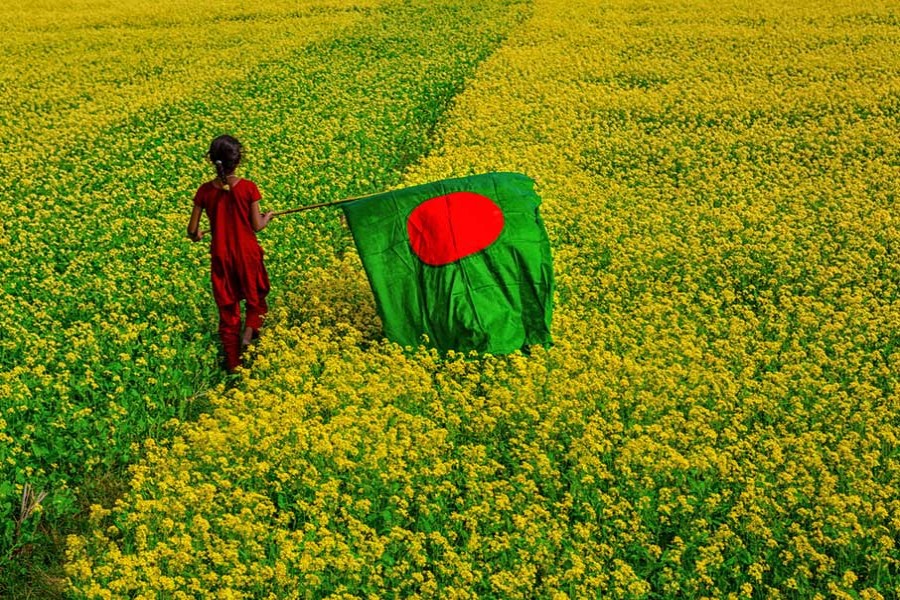As the Household Income and Expenditure Survey 2016 (HIES) of the Bangladesh Bureau of Statistics (BBS) shows, four-fifths of the households in Bangladesh access drinking water from tube wells. In rural areas, the share is estimated to be about 95 per cent as against only 60 per cent in urban areas. But despite improvements in accessing water, experts continue to express their concern over the quality of drinking water. The proportion of people using water from tube wells, in both rural and urban areas, however, remained more or less the same in 2010. This indicates that except in urban areas, in slums particularly, access to water and sanitation has marked improvement.
The same survey shows that roughly two-thirds of households in Bangladesh have access to sanitary/pucca latrines - half in rural and four-fifths in urban areas. By and large, the access to sanitary latrines has increased over time in both rural and urban areas; only about 3 in 100 households use open space that reflects a marginal improvement over 2010 open defecation. More importantly, Bangladesh has done better than some of the neighbours in terms of these two accesses. Notwithstanding improvements over time in sanitation, the quality of sanitary latrines poses a concern. It also appears that both in the access to drinking water and sanitation, the pace of progress has slowed down marginally over time. However, there is little doubt that both government and non-governmental organisations (NGOs) played important roles in this improvement over time.
HIES 2016 provides the good news that consumption of rice per capita, in both rural and urban areas, has gone down between 2010 and 2016. The most important cereal item rice has dropped to 367 gm/person/day in 2016 from 416 gm in 2010. This should be considered good news as it indicates that people tend to diversify consumption of food items.
Likewise, consumption of wheat marginally decreased in the comparable periods both in urban and rural areas. The growth in wheat availability in the market must then meet demand for non-consumption needs. Very importantly, HIES shows that the consumption of pulses, vegetables, fish, meat and egg has increased over time along with edible oil, onion and beef. This trend seems to be in line with available literature where it is being argued that, as per capita income rises, people tend to switch from cereals to income-elastic goods and services.
The famous Engel curve seems to fit well in the context of Bangladesh where per capita income has been rising at 4.0 per cent or more per annum. The average monthly income at Tk.15,945 in 2016 is three times more than that of 2000 at Tk 5,842. The gini coefficient of income has increased from 0.458 in HIES 2010 to 0.483 in 2016 indicating an increase in the concentration of income. The gini coefficient of consumption, however, rose from 0.321 to 0.324 - lower than inequality in income. Interestingly, however, inequality in consumption decreased in urban areas whereas it increased in rural areas.
Among non-cereal items of consumption, consumption of milk and milk products, fruits and protein items has gone down during the comparable periods. The rise in income inequality should ring a bell of warning as inequality and poverty reduction are inexplicably linked.
By and large, food expenditure as percentage of household consumption has fallen from about 55 per cent in 2000 to about 48 per cent in 2016 while non-food expenditure has risen from 45 to 52 per cent respectively during the same comparable period. Of course in rural areas, the share of food is higher than non-food expenditure.
HIES also reports distribution of monthly household consumption by major expenditure group. First, average consumption expenditure went up over time both in rural and urban areas with a pointer that rural consumption remained 72 per cent of urban ones in 2016 whereas it was 62 per cent in 2010. There had been an increase in medical as well as educational expenses between 2016 and 2010. So was cloth and footwear expenditure.
HIES 2016 reports that the overall calorie intake per capita per day decreased to 2210 K.cal in 2016 from 2308 K.cal in 2010. This decrease may be due to substantial decrease in rice consumption over time.
The head count rates of incidence of poverty has decreased during the comparable period, using lower poverty line, from about 18 per cent in 2010 to about 13 per cent in 2016. The rate using upper poverty line stood at 24 and about 32 per cent respectively. Thus within a span of six years or so, there has been appreciable decrease in the incidence of poverty. If the upper poverty line estimate is compared with about 49 per cent of 2000, it appears that poverty nearly halved within one and a half decade.
As far as regional performance in poverty reduction is concerned, the ace performer seems to be Dhaka with reduction from about 31 per cent to 16 per cent between 2010 and 2016. It is because of high reduction in the rural areas of this division.
Access to social safety net which contributes to poverty reduction increased significantly during 2010-2016; the share of households estimated to be about 28 per cent from 24 per cent. More importantly, the literacy rate of population among 7 years and above increased from about 58 per cent to about 66 per cent in 2016. Enrolment in both primary and secondary level education increased substantially between 2010 and 2016.
The socio-economic improvement of the people of Bangladesh has been borne out by the HIES 2016. Once access to tube wells and toilets marked anti-poverty drive; now it is beyond tube wells and toilets - quality rather than quantity.
The writer is a former Professor of Economics at Jahangirnanagr University


